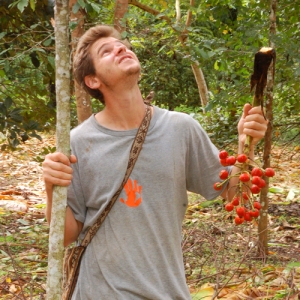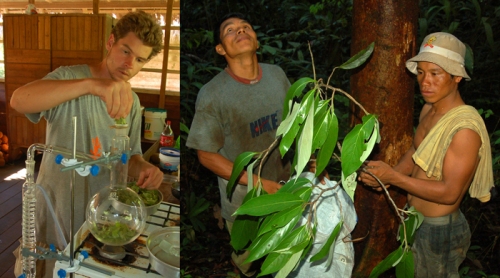
Robin van Loon with shaman Don Ignacio Duri at Infierno © Photo by Campbell Plowden/Center for Amazon Community Ecology

Robin van Loon and pijuayo palm fruit at Baltimori. © Photo by Campbell Plowden/Center for Amazon Community Ecology
Officers of the Marjorie Grant Whiting Center for Humanity Arts and the Environment (MGWC) introduced Robin and CACE Executive Director Campbell Plowden to each other in 2010 to see if they could combine their distinct experience and methods to enhance forest conservation and support sustainable livelihoods in the northern and southern ends of the Peruvian Amazon.

Plowden, van Loon and Camino Verde forester at Baltimori. © Photo by David Imburgia/Center for Amazon Community Ecology
1) CACE is helping Camino Verde to develop a scientifically based study of the sustainable harvest of medicinal latex from several hundred sangre de grado (“dragon’s blood”) trees planted at Baltimori in the Tambopata River region.

Sangre de grado latex harvest experiment at Baltimori. © Photo by Campbell Plowden/Center for Amazon Community Ecology
2) Camino Verde is the technical advisor and co-financer of a project to plant 1000 rosewood tree seedlings in secondary forest fields in the Bora native community of Brillo Nuevo on the Ampiyacu River. When the trees mature, CACE will work with the community to distill the leaves into a marketable fragrant essential oil.

Distilling camphor moena leaves at Baltimori; Bora woodsmen collecting canoela moena leaves at Brillo Nuevo. © Photos by Campbell Plowden/Center for Amazon Community Ecology
3) CACE and Camino Verde are conducting trial distillations of leaves and branches from several sister species of “moena” trees to develop novel essential oils from Amazon rosewood relatives (family Lauraceae). Promising products will be developed for sale to fragrance companies to generate income for forest communities.
Both groups seek ongoing support for these initiatives. Donations may be sent to support them through the online non-profit funding platform Global Giving. The CACE campaign – Project # 12229 will “go live” on November 26.
Other links and related stories:
The Legacy of a Rosewood Tree
A Dying Copal Tree and Rosewood Seedlings at Jenaro Herrera
Steaming Leaves and Heated Emotions
Visions of Rosewood Oil and Ayuhuasca
Camino Verde on Facebook
CACE on Facebook

Comments will be approved before showing up.


